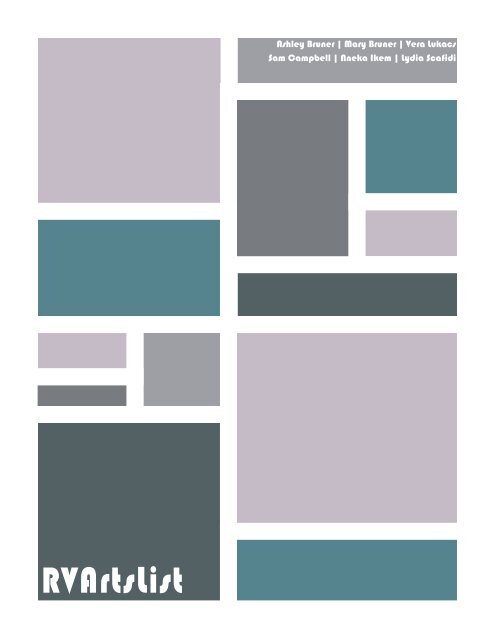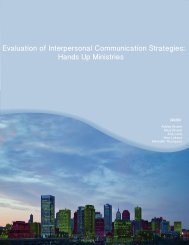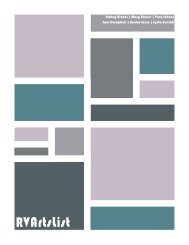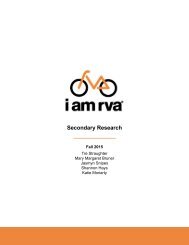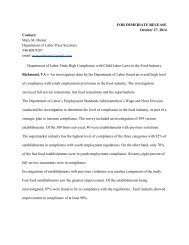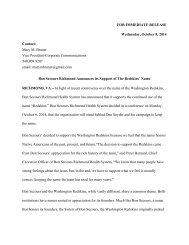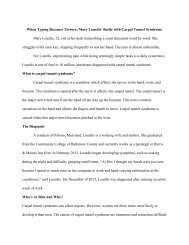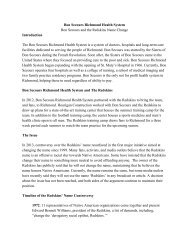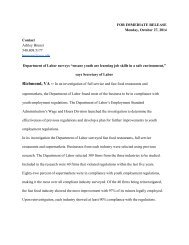rvaartslistdraft (4)
- No tags were found...
You also want an ePaper? Increase the reach of your titles
YUMPU automatically turns print PDFs into web optimized ePapers that Google loves.
RVArtsList<br />
Ashley Bruner | Mary Bruner | Vera Lukacs<br />
Sam Campbell | Nneka Ikem | Lydia Scafidi
table of contents<br />
Introduction<br />
Audience<br />
Research<br />
1<br />
2<br />
3-5<br />
RVArtsList + Groundswell<br />
Campaign Objectives, Strategies + Tactics<br />
Platforms<br />
Collaboration<br />
6<br />
7<br />
8-9<br />
10<br />
Content + Anecdotes<br />
11-13<br />
Campaign Analysis + Measurement Data<br />
14-17<br />
The Future of Socia Media<br />
18
introduction<br />
Richmond, Virginia is home to the currently ranked #1<br />
public art school in the country: Virginia Commonwealth<br />
University. With 3,000+ students currently enrolled in art<br />
programs at VCU there is an immense and immediate<br />
need for resources for cheaper, easier portfolio building.<br />
The idea behind RVArtsList is this: provide a platform for<br />
artists to search for and provide services to other artists.<br />
Imagine this: a painting and printmaking major in her<br />
third year has sunk hundreds of dollars into building her<br />
portfolio, from hiring models to buying canvases. Now,<br />
imagine a first year painting and printmaking major who<br />
is discontinuing his studies and is thus left with canvases<br />
and supplies he will no longer need. RVArtsList seeks<br />
to connect these two individuals and many others who<br />
are looking for free or discounted services and supplies.<br />
The basis behind why we chose this topic is simple:<br />
need. A city full of artists and art students will always<br />
be in search of services and supplies to express<br />
themselves. RVArtsList will fill that need.<br />
1
audience<br />
In developing methods of research to determine the<br />
most effective, appropriate platforms for RVArtsList, we<br />
had one target audience: VCU art students.<br />
We selected VCU art students as our target audience<br />
because we perceived them to have the most immediate<br />
need for our community.<br />
Though VCU art students will form the base of our audience,<br />
we expect the community to eventually encompass<br />
all local artists and those individuals or businesses<br />
looking to purchase art.<br />
2
esearch<br />
Before we chose our social media platforms and established<br />
our objectvies, we neeed to get an idea<br />
of what the community wanted from us, and what<br />
methods of communication they were already using.<br />
We designed a 10 question survey using SurveyMonkey.<br />
The questions measured our audience’s demographics,<br />
wants, and needs. We also included questions designed<br />
to evaluate which communications platforms<br />
they were currently using, and which they preferred.<br />
Below, we will examine the questions in further detail.<br />
Demographics<br />
Occupation<br />
Age<br />
We included two demographics questions that measured respondents’<br />
age and how they classify themselves (artist, designer,<br />
art enthusiast, model, curator, business owner, other)<br />
From our results, we gathered that 90% of our respondents<br />
are aged 18-24, and 87.5% classify themselves as “artists.”<br />
3
Communication + Social Media Use<br />
Three questions in the<br />
survey pertained to respondents’<br />
current communication<br />
method<br />
and their social media<br />
use and preferences.<br />
First, we asked respondents<br />
how they currently<br />
communicate with other<br />
members of the art community.<br />
Half of the respondents<br />
said social media<br />
was their preferred communication<br />
method, while<br />
25% said word of mouth.<br />
Second, we wanted to<br />
see exactly how often<br />
our respondents’ logged<br />
on to social media. We<br />
found that every respondent<br />
logged on daily,<br />
and 77.78% of respondents<br />
reported logging on<br />
more than once a day.<br />
Next, we had respondents<br />
rank their preferred<br />
social media. Our respondents<br />
indicated that<br />
their most preferred platforms<br />
were Tumblr, Instagram,<br />
and Facebook.<br />
4
Wants + Suggestions<br />
Our survey included two questions that allowed respondents to type their<br />
answers. We used the questions to see what specific features respondents<br />
would like to see in RVArtsList, and gather suggestions they had for the community.<br />
Below, are listed the two questions and a selection of responses.<br />
Question One: “What kind of features would you like to see on an online<br />
community like this?”<br />
“Customizable profiles, lots of features to communicate with<br />
other artist...”<br />
“A feature to organize collaborations, raise funds for projects,<br />
stay updated on changes in the local art community (newspaper-esque)...”<br />
Question Two: “In regards to creating an online community to connect<br />
artists, do you have any comments or suggestions?”<br />
“I would suggest deciding what area you want the community<br />
to span. Connecting artists across the globe is an awesome<br />
idea which great things could come from but there’s also a lot<br />
to be said for keeping it more locally focused; really defining<br />
those parameters I think would be a good start. Also, deciding<br />
whether or not money will be involved (e.g. in allowing artists<br />
to sell their work via a certain feature of the site) will play a big<br />
role in composing the feel of the community.<br />
“Maybe be aware of copyright stuff. I know a few folks who<br />
have had art stolen bc they’ve posted it online. Maybe a watermark<br />
or be able to link artwork to the artists portfolio/site?”<br />
5
RVARTSLIST+<br />
GROUNDSWELL<br />
P profiles<br />
We identified our target audience as VCU art students. We estimated<br />
that the age range for our target audience was 18-24 years old.<br />
The Social Technographics Profile of U.S. adults aged 18-24 indicates<br />
that 85% of individuals in that group are “joiners.” According<br />
to Groundswell, “joiners” are those who “participate in or maintain<br />
on a social networking site…” (Li & Bernoff, 2011, p. 45).<br />
O<br />
There is an already strong community of artists within the VCU art<br />
school. Our main objective with RVArtsList was to support our audience.<br />
RVArtsList was intended to be an online community for artists to<br />
source the supplies needed for portfolio building. We want to support<br />
the functions that artists participate in outside of the groundswell.<br />
S<br />
T<br />
Because we sought to support our audience, our strategy was<br />
to provide a central online location for artists to congregate, engage,<br />
and crowdsource. Although Groundswell discusses strategies<br />
for corporations, we translated their question, “how do you<br />
want relationships with your customers to change?” to “how do<br />
you want relationships between audience members to change?”<br />
We surveyed our target audience to see which social networks<br />
they were joining. Our surveys indicated that our audience uses<br />
Tumblr and Facebook most often, followed by Instagram and<br />
Twitter. Because the nature of our community, we concluded<br />
that Facebook and Twitter fit the needs of our audience.<br />
6
objectives+ strategies+<br />
tactics<br />
Objective 1<br />
Objective 1<br />
To increase interaction between individuals in the art<br />
community through facilitated conversations between<br />
15% of our followers and members of RVArtsList social<br />
media accounts.<br />
Strategy 1.1<br />
Harness the referent power of local<br />
business owners and artists to increase<br />
credibility and increase group membership<br />
and followership.<br />
Tactic 1.1.1<br />
Tactic 1.1.2<br />
Reach out to local<br />
business owners who<br />
are in need of art for<br />
their space.<br />
Facilitate conversations<br />
on social media accounts<br />
To increase awareness of local art-related events by<br />
10%.<br />
Strategy 1.1<br />
Promote events happening in the local<br />
art community to a following base of<br />
local artists, art enthusiasts and business<br />
owners.<br />
Tactic 1.1.1<br />
Retweet event postings<br />
from local galleries, artists<br />
and businesses.<br />
Tactic 1.1.2<br />
Tweet media and fliers<br />
related to upcoming<br />
events using #RVA.<br />
7
platforms<br />
The target audience for RVArtsList is VCU art students aged<br />
18-24. Using the social technographics profile, we found<br />
that 85% of people in this age group are joiners, meaning<br />
they have and/or maintain profiles on social networks.<br />
Our survey indicated that our audience uses the following<br />
social networks (listed in order of most used to least used):<br />
Tumblr<br />
Facebook<br />
Instagram<br />
Twitter<br />
Pinterest<br />
LinkedIn<br />
The social networks we chose for our community needed<br />
to serve two functions: allow for interaction between<br />
community members and provide a way for<br />
us to easily repost content from relevant sources. Because<br />
of that, we concluded that Facebook and Twitter<br />
would best serve those needs. The next two pages<br />
will discuss our chosen platforms in further detail<br />
8
Facebook<br />
Facebook tied with Tumblr<br />
for most used social network<br />
among our audience. We chose<br />
Facebook for three reasons:<br />
Facebook has the option to create<br />
a “group” where people can<br />
join, instead of just ‘like’ the page.<br />
Group membership on Facebook allows<br />
to tap the 46% of our target audience<br />
who fall under the “creator”<br />
category in the social technographics<br />
profile. They are able to create and<br />
post original content to the group.<br />
Facebook allows members to privately<br />
message each other and create<br />
private event pages that will make for<br />
an easier crowdsourcing experience.<br />
Twitter<br />
We chose Twitter for three<br />
reasons:<br />
Twitter allows us to interact<br />
with small businesses and other<br />
organization that could benefit<br />
from RVArtsList members<br />
“Re-tweeting” content from<br />
relevant media outlets and<br />
organizations increases<br />
awareness of our community.<br />
Allowed us to more easily talk<br />
to the groundswell as an organization,<br />
rather than moderators<br />
of a Facebook group.<br />
9
collaboration<br />
To create a brand for our community, we needed to make sure that our<br />
content was cohesive across all platforms. In order to do this we created<br />
a content calendar that was split into two sections: twitter and facebook.<br />
We decided on basic daily content of different categories: upcoming<br />
events, news, interesting finds and housekeeping items (i.e. rules and<br />
regulations). Once the content calendars were created we split the<br />
team into two sections: Mary-Margaret, Vera and Ashley handled the<br />
twitter account while Sam, Vera and Lydia handled Facebook posts.<br />
The division between platforms<br />
helped us keep content from<br />
being repetitive. In some cases,<br />
however, we reposted content on<br />
Twitter that was originally on Facebook<br />
if we deemed the content to<br />
be appropriate for both platforms.<br />
The division was strictly organizational,<br />
team members collaborated<br />
on any additional content to<br />
be posted even it was not within<br />
their designated platform. This especially<br />
held true in posts relating<br />
to upcoming events, as team members would collaborate on finding<br />
upcoming events. For example, Ashley saw a flyer for an event at work,<br />
and posted it to Facebook though her assigned platform was Twitter.<br />
Facebook collaboration also included a third party: group members. The<br />
majority of content posted to Facebook was by outside group members. The<br />
team facilitated posts by posting relevant content to keep the page fresh.<br />
10
content+anecdotes<br />
Below are some screenshots and anecdotes from our experience<br />
building and running an online community.<br />
8 April 2015<br />
The cuddle salon “Cuddle RVA” was set to open on Monument<br />
avenue. Prior to its opening, social media and news outlets were<br />
covering it like crazy. While we were scrolling down the twitter<br />
feed we saw a tweet from them about needing art for their<br />
walls. We retweeted their original tweet then sent them a secondary<br />
tweet suggesting they join our Facebook group. The<br />
owner tweeted at us to say she sent the group a request to join<br />
and now she is officially a part of the RVArtsList Facebook group.<br />
11
19 April 2015<br />
We posted a poll on Facebook<br />
asking group members if they<br />
would attend an RVArtsList meetup,<br />
swap meet or yard sale.<br />
Though it was seen by 47, we only<br />
got 11 responses. The responses<br />
were positive, but illustrated<br />
that group membership does not<br />
necessarily mean the person will<br />
actively participate -- even if its<br />
as simple as checking a box. Engagement<br />
with our target audience<br />
wasn’t our main objective;<br />
we ultimately wanted to facilitate<br />
engagement between members.<br />
This poll proved that our members<br />
want the same for the group also.<br />
12
20 April 2015<br />
We tweeted about RVA Restaurant<br />
Week using “#RVA” (a hashtag used<br />
by all local news outlets and organizations)<br />
and we were retweeted by<br />
an organization called RVA Source<br />
who’s bio says “Retweeting & originating<br />
what’s happening in #RVA.” The<br />
retweet caused us to gain 4 new followers<br />
within the hour. It proved to us<br />
how important it is to retweet and be<br />
retweeted by reputable organizations<br />
and twitters. It proved more follower-lucrative<br />
than going through and following<br />
people in hopes of a follow back.<br />
13
campaign analysis+<br />
measurement data<br />
Facebook Summary<br />
At the beginning of the project we struggled with getting Facebook<br />
users to join the group. Unlike a page that you “like,”<br />
group membership is a slightly elevated level of commitment.<br />
You are sent a notification every time a member posts<br />
in the group. Group membership started off slow because<br />
we didn’t take the route of sending invites, rather we posted<br />
about the group on other relevant pages. When we started<br />
sending personal invites to people, group membership skyrocketed<br />
from 10 members to 50 in the period of a few days.<br />
Next time we are tasked with building an online community<br />
in a Facebook group, we will definitely build our membership<br />
base through personal invites. We learned that after we<br />
built a base membership of around 60 members, people began<br />
to send requests to join the group because it now had<br />
more credibility than it had with only 10 members. The main<br />
takeaway we drew from this experience is that, on Facebook,<br />
credibility in the forms of “likes” or “members” is key.<br />
We used Grytics to analyze our Facebook group engagement. Of<br />
our 120 members, 40 are active, meaning they post, like, or comment<br />
regularly. RVArtsList has 23 total posts, 89 total likes, and 12 comments.<br />
Of our 23 total posts, 74% were “liked” or commented on.<br />
14
Facebook Stats<br />
15
Twitter Summary<br />
Twitter proved to be difficult throughout the duration of<br />
the project. We started out going on a following spree.<br />
Though we followed around 150 people, we only got<br />
about 20 follows back. After we ramped up our retweets<br />
of other organizations and users, our followership doubled.<br />
This project taught us that engagement on Twitter is not as easy as<br />
you would assume. One tip we always hear about Twitter is to ask<br />
your followers questions they’d enjoy answering. Following that<br />
tip, we tweeted asking our followers who their favorite local artists<br />
are. We got no responses. In the future, we will follow the tip given<br />
to us by guest speaker Adam Crowe: if there is an existing, popular<br />
hashtag, use it rather than creating your own. Failure to use<br />
the “#RVA” in the majority of our posts stunted our engagement.<br />
We analyzed our Twitter success using Twitter Analytics. Using that,<br />
we found that our tweets earned 1.3K impressions from 13 April to<br />
22 April. Additionally, our top tweet earned 129 impressions over a<br />
two day period. On average, we have a 5.3% engagement rate.<br />
The RVArtsList profile was viewed 787 times. RVArtsList is followed<br />
by a Luis Rosenfeld (@luisrosenfeld), who has 20.6K followers.<br />
16
Twitter Data<br />
17
the future of<br />
social media<br />
The future of social media for organizations is bright, but<br />
expensive. In the future we see more platforms adopting<br />
a paid advertising format for business pages.<br />
A few years ago, Facebook implemented a new system for business<br />
pages where they must pay to serve their posts to all of<br />
their following. Similarly, Twitter allows users to pay to promote<br />
their posts to users who don’t follow them, but doesn’t limit the<br />
amount of followers who can see their tweets. We believe this<br />
will change. In the future, we see Twitter charging business pages<br />
to serve their Tweets to all of their followers. Personal pages<br />
will remain unchanged, but business pages will now need<br />
to budget in order to promote themselves to their followers.<br />
Because of this change, social media managers might see pushback<br />
from their CEOs on budgeting money for social media advertising.<br />
Social media managers will need to be savvy in their justification<br />
of social media accounts and provide detailed ROI data to CEOs.<br />
The conclusion: the lines between social media<br />
and paid advertising will become blurred.<br />
18


